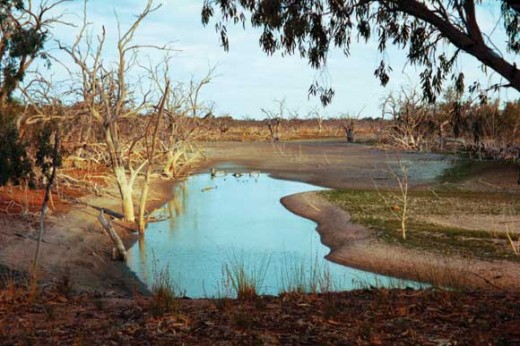Murray-Darling crying out for water
Thursday, August 25th, 2011 A dying river near Broken Hill, NSW (not so long ago)
A dying river near Broken Hill, NSW (not so long ago)is visited by Chris Daley, the Wilderness Society rivers campaigner. Photo by Dean Sewell
.
Despite common perceptions, the problems facing the Murray-Darling Basin are not confined to rural communities, and their social implications are extensive.
Adelaide, for example, relies on the Murray-Darling to provide around 55% of its drinking water. In fact, more than four million people depend on the Basin for water. But the future of the Murray-Darling and its communities are under threat from over-extraction of water, salinity and climate change. The Basin supports diverse communities that have grown up on the river, and who consider it to be central to their way of life. Locals see the river as extremely important from a social point of view, as Barney Stephens from the Darling River Action Group pointed out.
“The lakes and the Darling River and the Anabranch are basically Broken Hill’s recreation. People think of recreation as something that’s maybe not essential, but when you look at an isolated town like Broken Hill, if you take the lakes away and the rivers away it’s like taking the beaches away from Sydney.”
Dr. James Pittock, Programme Leader of Australian and United States Climate, Energy and Water at the US Studies Centre, Australian National University, agrees that returning water to the Basin is socially and economically important.
.
Multiple Benefits
.
“The water in the Murray-Darling Basin provides lots of different benefits for people, and many of those benefits are gained from leaving water in the river, in terms of providing habitat for fish right through to the Lower Lakes and Coorong near the sea where [there are] massive fishing industries, both commercial and recreational”, said Pittock.
Both men also point to the cultural significance of the river to aboriginal people that have lived by the river for thousands of years. “Most of them [in the Broken Hill area] were Paakantji, which means ‘river people’, and the river is just essential to them,” said Stephens.
While irrigators have argued that the Basin Plan has the potential to damage rural communities, Dr. James Pittock says the social consequences of not returning health to the river will be far worse.
“If this Basin Plan isn’t implemented well, that is if the reform isn’t substantial in quickly reallocating a lot of water from agriculture to the environment, we risk another crisis in a few years time.”
.
Best chance in a generation
.
“We will be back to this public dispute over water allocation…and eventually industry will be forced to cut back to sustainable levels. Now the question for the industry is, do you want to do that now, and do it with some certainty so that rural communities can get on with planning a more sustainable future? Or alternatively, if this opportunity for reform is fudged in some political compromise, do you really want to live with the uncertainty of repeating the exercise every five to ten years when the next drought hits?”
Right now, the Government and the Murray-Darling Basin Authority (MDBA) have a responsibility to rectify these problems once and for all in the development of the Murray-Darling Basin Plan. To do so, they must commit to buying back 7,600 gigalitres of water to be returned to the system. This was the scenario identified in the MDBA’s Guide to the proposed Basin Plan as carrying the least risk of irreversible damage to the river system.
The Wilderness Society is urging the Australian Government to spend the $10 billion of taxpayers’ money allocated to save the Basin wisely, or give the Australian public their money back. Responsible and scientifically based action to ensure the sustainability of the Basin will help to build stronger, more diverse rural communities.
 Menindee Lakes —inlet to Lake Cawndilla during drought in 2003
Menindee Lakes —inlet to Lake Cawndilla during drought in 2003(MDBC Annual Report 2003-04, Photo: L. Palmer)
.
.
.
Further Reading:
.
[1] Jamie Pittock BSc. Hons (Monash), PhD (ANU) is ‘Director of International Programs for the UNESCO Chair in Water Economics and Transboundary Water Governance, Program Leader, Australia and United States – Climate, Energy and Water, US Studies Centre and ANU Water Initiative. Jamie Pittock is Director of International Programs for the UNESCO Chair in Water Economics and Transboundary Water Governance. His current work includes developing research programs that link Australian and southern African expertise to improve management of river basins, green water and agriculture. He is also Program Leader for the Australia and United States – Climate, Energy and Water project of the US Studies Centre and ANU Water Initiative. [Read More].
[2] Darling River Action Group, ^http://www.d-r-a-g.org.au/
[3] Paakantji, ^http://www.curriculumsupport.education.nsw.gov.au/secondary/languages/languages/aboriginal/campfire/stories/paakantji/paakantji_stories.htm
[4] The Wilderness Society (NSW), River Protection Campaigns, ^http://www.wilderness.org.au/campaigns/river-protection
[5] ‘Living Murray, Dying Darling – the year our fish died and Broken Hill cried,’ speech by Joe Flynn, Managing Director, Australian Inland at the Murray Darling Association Annual Conference in Renmark, South Australia 20040902. [Read More]
[6] ‘Great Darling Anabranch to receive much-needed environmental flows‘, Murray-Darling Basin Authority (MDBA), 20100909, ^http://www.mdba.gov.au/media_centre/media_releases/great-darling-anabranch-to-receive-much-needed-environmental-flows, [Read More]
.
– end of article –









